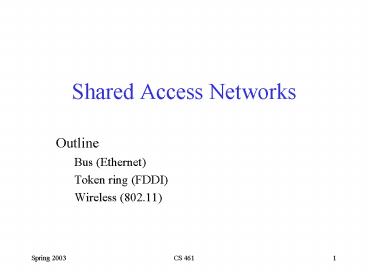Shared Access Networks - PowerPoint PPT Presentation
Title:
Shared Access Networks
Description:
How does communication work in real life? If there are ... MACAW. Sender transmits RequestToSend (RTS) frame. Receiver replies with ClearToSend (CTS) frame ... – PowerPoint PPT presentation
Number of Views:21
Avg rating:3.0/5.0
Title: Shared Access Networks
1
Shared Access Networks
- Outline
- Bus (Ethernet)
- Token ring (FDDI)
- Wireless (802.11)
2
Gedankenexperiment
- How does communication work in real life?
- If there are lots of speakers/speaking?
- If there is little speaking?
- If there are important people?
- Can we map this to computer networks?
3
Mechanics
- Reading Section 3.1-3.3
- Textbook errata via LLPs page
4
Ethernet Overview
- History
- developed by Xerox PARC in mid-1970s
- roots in Aloha packet-radio network
- standardized by Xerox, DEC, and Intel in 1978
- similar to IEEE 802.3 standard
- CSMA/CD
- carrier sense
- multiple access
- collision detection
- Frame Format
5
Ethernet (cont)
- Addresses
- unique, 48-bit unicast address assigned to each
adapter - example 80e4b12
- broadcast all 1s
- multicast first bit is 1
- Bandwidth 10Mbps, 100Mbps, 1Gbps
- Length 2500m (500m segments with 4 repeaters)
- Problem Distributed algorithm that provides fair
access
6
Transmit Algorithm
- If line is idle
- send immediately
- upper bound message size of 1500 bytes
- must wait 9.6us between back-to-back frames
- If line is busy
- wait until idle and transmit immediately
- called 1-persistent (special case of
p-persistent)
7
Algorithm (cont)
- If collision
- jam for 32 bits, then stop transmitting frame
- minimum frame is 64 bytes (header 46 bytes of
data) - delay and try again
- 1st time 0 or 51.2us
- 2nd time 0, 51.2, 102.4, or 153.6us
- nth time k x 51.2us, for randomly selected
k0..2n - 1 - give up after several tries (usually 16)
- exponential backoff
8
Collisions
A
B
A
B
A
B
A
B
9
Token Ring Overview
- Examples
- 16Mbps IEEE 802.5 (based on earlier IBM ring)
- 100Mbps Fiber Distributed Data Interface (FDDI)
10
Token Ring (cont)
- Idea
- Frames flow in one direction upstream to
downstream - special bit pattern (token) rotates around ring
- must capture token before transmitting
- release token after done transmitting
- immediate release
- delayed release
- remove your frame when it comes back around
- stations get round-robin service
- Frame Format
11
Timed Token Algorithm
- Token Holding Time (THT)
- upper limit on how long a station can hold the
token - Token Rotation Time (TRT)
- how long it takes the token to traverse the ring
- TRT lt ActiveNodes x THT RingLatency
- Target Token Rotation Time (TTRT)
- agreed-upon upper bound on TRT
12
Algorithm (cont)
- Each node measures TRT between successive tokens
- if measured-TRT gt TTRT token is late so dont
send - if measured-TRT lt TTRT token is early so OK to
send - Two classes of traffic
- synchronous can always send
- asynchronous can send only if token is early
- Worse case 2xTTRT between seeing token
- Back-to-back 2xTTRT rotations not possible
13
Token Maintenance
- Lost Token
- no token when initializing ring
- bit error corrupts token pattern
- node holding token crashes
- Generating a Token (and agreeing on TTRT)
- execute when join ring or suspect a failure
- send a claim frame that includes the nodes TTRT
bid - when receive claim frame, update the bid and
forward - if your claim frame makes it all the way around
the ring - your bid was the lowest
- everyone knows TTRT
- you insert new token
14
Maintenance (cont)
- Monitoring for a Valid Token
- should periodically see valid transmission (frame
or token) - maximum gap ring latency max frame lt 2.5ms
- set timer at 2.5ms and send claim frame if it
fires
15
Who Is This Woman?
- Hints
- Escaped Austria
- Hated Nazis
- Samson and Delilah
- Romanced a pianist
16
Wireless LANs
- IEEE 802.11
- Bandwidth 1 - 11 Mbps
- Physical Media
- spread spectrum radio (2.4GHz)
- diffused infrared (10m)
17
Spread Spectrum
- Idea
- spread signal over wider frequency band than
required - originally designed to thwart jamming
- Frequency Hopping
- transmit over random sequence of frequencies
- sender and receiver share
- pseudorandom number generator
- seed
- 802.11 uses 79 x 1MHz-wide frequency bands
18
Spread Spectrum (cont)
- Direct Sequence
- for each bit, send XOR of that bit and n random
bits - random sequence known to both sender and receiver
- called n-bit chipping code
- 802.11 defines an 11-bit chipping code
19
Collisions Avoidance
- Similar to Ethernet
- Problem hidden and exposed nodes
20
MACAW
- Sender transmits RequestToSend (RTS) frame
- Receiver replies with ClearToSend (CTS) frame
- Neighbors
- see CTS keep quiet
- see RTS but not CTS ok to transmit
- Receive sends ACK when has frame
- neighbors silent until see ACK
- Collisions
- no collisions detection
- known when dont receive CTS
- exponential backoff
21
Supporting Mobility
- Case 1 ad hoc networking
- Case 2 access points (AP)
- tethered
- each mobile node associates with an AP
22
Mobility (cont)
- Scanning (selecting an AP)
- node sends Probe frame
- all APs w/in reach reply with ProbeResponse
frame - node selects one AP sends it AssociateRequest
frame - AP replies with AssociationResponse frame
- new AP informs old AP via tethered network
- When
- active when join or move
- passive AP periodically sends Beacon frame































